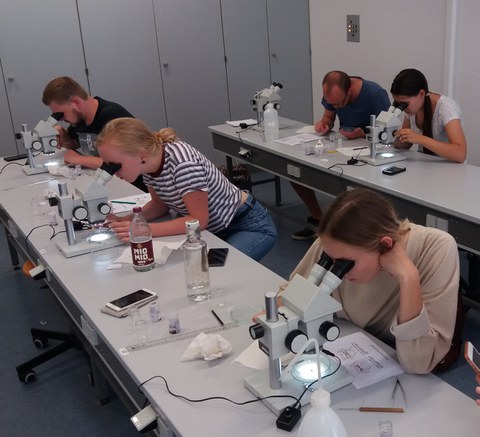Descriptions of master modules
This information in English is just a brief summary of the original German description and not an official and binding description of the Module!
Habitat design in forests
Contents and learning goals: Students are able to record, analytically process and assess the habitat function of forests for animal and plant species using goal-oriented methods. They are able to describe the habitat requirements of organisms/populations using the structural element and habitat concepts. In addition, the students have their own understanding of habitat dynamics (succession and fluctuation). Students are able to conceptualize silvicultural and structure-oriented design options at the stand level. The students know and master the application of silvicultural objectives through the spatial combination of structural elements as well as the use of space-time dynamics in stands. The students know the control of ecosystem-relevant processes by species as a prerequisite for the optimization of the self-regulation capacity of forests.
The summer semester is a practice-orientated semester. Using ground beetle catches on various structural elements (e.g. dead wood, gaps etc.) in the Tharandt Forest and simplified vegetation surveys, the aim is to show how silvicultural management affects biodiversity and species communities using the example of ground beetles/arthropods.
The winter semester is characterised by seminars. Presentations will be used to illustrate the influence of the structural elements sampled in the summer semester on ground beetles, but also on other species, and to discuss silvicultural management to create these structures.
Contact: Dr. Katharina Tiebel, Prof. Dr. S. Seibold, Dr. J. Fält-Nardmann
This information in English is just a brief summary of the original German description and not an official and binding description of the Module!
Wildlife habitat use
Contents of the module are methods for qualitative and quantitative recording and visualization of the space use of wildlife species, natural and anthropogenic control variables of wildlife space use, modeling of the dynamics of selected wildlife species and management measures for the optimization of wildlife habitats.
Qualification Objectives: Students will possess the ability to assess the spatiotemporal pattern of wildlife species (mammals, birds) in different structured landscape sections and as a prerequisite for developing management concepts in forestry and nature conservation. In addition, they have knowledge of individual-based modeling and threat level analysis.
Contact: Prof. Dr. Sebastian Seibold , Dr. rer. nat. Suzanne van Beeck Calkoen
This information in English is just a brief summary of the original German description and not an official and binding description of the Module!
Methodology natural resources
Contents: The students know exemplary methods for the analysis, characterization and evaluation of the impacts and services of forest and selected agro-ecosystem types, wetlands as well as water bodies, can analyze anthropogenic influences and evaluate them for use, development and planning. Important topics are the meteorological-climatic factor complex (air quality and climate), water balance (water quantity), water quality (water quality), soil functions and primary production as well as genetic diversity or biodiversity.
Upon completion of this module, students are able to apply their knowledge of the natural sciences in a practical way. They possess methodological skills and understand the interaction of relevant disciplines in solving problems of management of the environmental resources air, water and soil, as well as genetic resources and production, (food, energy) and specific environmental threats. They are able to analyze complex problems, to solve them integrally with the methods of different disciplines, to evaluate them and to present them orally and in writing in a generally understandable way.
Contact: Prof. Dr. Karsten Kalbitz, Prof. Dr. Sebastian Seibold, Dr. phil. Julia Fält-Nardmann
Please refer also to the resources of the Chair of Tropical Forestry:
Studying at the chair of Tropical Forestry
Study- and examination regulations
FOMT 1.8A: Natural Forest Silviculture and Biodiversity Conservation in the Tropics
Contents:
Ecosystem concept as an auxiliary for silviculture and for biodiversity conservation.
Natural distribution and classification of forest and plant formations, as well as fauna in
the tropics, as well as methods for their assessment. Important silvicultural systems with
their methods and techniques in moist and dry forests. Population ecology with its natural
regulation mechanisms, relationships between plants, herbivores, as well as between
herbivores and their antagonists in the context of biodiversity and protection.
Qualification goals:
The students are able to classify, analyse and evaluate tropical forest ecosystems and to
conceptualize appropriate silvicultural systems, according to the local conditions. They
can analyse the plant-herbivore-antagonist relationships and assess biotic risks and
regulation possibilities for natural forest management and thus the protection of
biodiversity, as well as integrate management strategies. The students are able to design
strategies for sustainable production and the protection of natural forest ecosystems.
FOMT 1.8B: Forest Plantation Silviculture and Agroforestry in the Tropics
Contents:
Silviculture and stages of production for forest plantations of pure and mixed stands as
well as tree-plantings as an integral part of agroforestry in the tropics and subtropics.
Case studies about representative genera and tree species with regional peculiarities.
Forest protection strategies and innovations in forest plantations. Artificially established
forest ecosystems and agroforestry systems as classified according to their functions.
Attributes and methods for their evaluation and certification.
Qualification goals:
The students are enabled to analyse, classify and evaluate forest plantations and
agroforestry systems by components, as well as to design integrated forest protection
strategies and to further develop innovative technologies. They are able to conduct
reconnaissance surveys as well as to conceptualize forest plantations and woody
components of agroforestry systems in the tropics.
Contact: Prof. Dr. Sebastian Seibold

